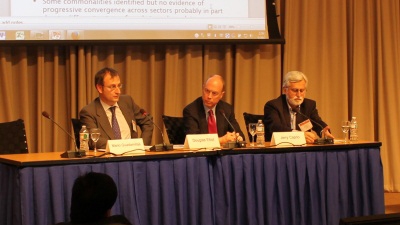In the wake of the recent financial crisis, policy makers grappled with how to respond to the Great Recession and the Euro Debt crisis. In an effort to prevent history from repeating itself yet again, legislators have introduced more stringent regulations, larger capital buffers, and greater oversight. Did those measures go too far, or not far enough?
From May 19-23, 2014, the World Bank hosted the eleventh annual Overview Course of Financial Sector Issues in Washington, D.C. This week-long series attracts officials from central banks, ministries of finance, and financial regulatory agencies, as well as staff involved in financial operations from international development organizations (including the World Bank) and the private sector. This year’s course, entitled “Challenges and Priorities for Financial Sector Policy Makers,” was attended by 71 participants from 45 countries, as well as 51 representatives of the World Bank.
Each year, the World Bank organizes this course to bring researchers, practitioners, and policy makers together to discuss the most current issues in finance. A series of panels provides a platform for researchers and thought leaders from both inside and outside the World Bank to present their findings to policy makers from around the world.
The 30 speakers on the agenda included Charles Calomiris (Columbia University Graduate School of Business), Ceyla Pazarbasioglu (IMF) and Eswar Prasad (Cornell University and Brookings Institution), who jointly appeared on a panel exploring the main theme of this year’s course. In addition, Thorsten Beck (Cass Business School and Tilburg University) spoke on the role and importance of the financial sector, Viral Acharya (Stern School of Business, New York University) led a session on how to measure and regulate systemic risk while Anthony Saunders (also from the Stern School) discussed changes in bank risk management models.
Taking a broad view, Simon Johnson (MIT and Peterson Institute for International Economics), in a session entitled “Government Guarantees for Finance: Where They Came from and Where They Will Go Next,” traced the history of government guarantees for finance along with the scale, nature, and cost of the guarantees currently provided globally. Johnson demonstrated that the direct financial cost of the United States’ response to the crisis was ultimately zero. The real economic loss was in terms of output, with a gap of 5.5 percent in 2011 between real potential GDP and real GDP. He concluded that “the American financial system has not improved in safety” and warned participants to “expect to experience the same shocks and disruption” in the future.

